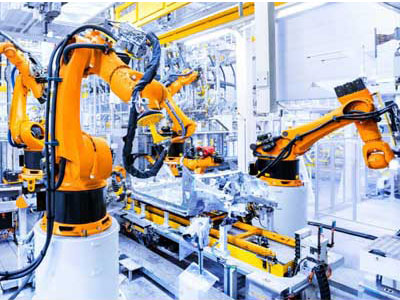Key Takeaway
Industrial robots come in various types, each with unique characteristics and uses.
Articulated Robotic Arms are flexible and can mimic human arm movements, making them versatile for tasks like welding and assembly.
Cartesian or Rectangular Robots move in straight lines along the X, Y, and Z axes, ideal for pick-and-place tasks.
SCARA Robots are great for vertical assembly operations due to their precise vertical movement.
Polar or Spherical Robots offer a wide range of motion and are used in tasks like machine loading.
Delta or Parallel Robots are fast and precise, perfect for packaging.
Gantry Robots are large and used for heavy load tasks.
Cylindrical Robots combine rotary and linear movements, suitable for simple assembly tasks.
Collaborative Robots (Cobots) work alongside humans, enhancing productivity safely.
Articulated Robots
Articulated robots, similar to the human arm, feature rotary joints that mimic human movements. These versatile robots excel in tasks requiring dexterity and flexibility, such as welding, painting, and assembly. Their multi-joint design allows for a wide range of motion, making them ideal for complex operations across various industries. This adaptability ensures high efficiency and precision in performing intricate tasks, enhancing productivity in manufacturing, automotive, and electronics sectors.

SCARA Robots
SCARA (Selective Compliance Assembly Robot Arm) robots are a cornerstone in modern manufacturing, prized for their ability to perform high-speed and precise tasks with remarkable accuracy. These robots are designed to handle assembly and pick-and-place applications swiftly and reliably, making them indispensable in industries where meticulous handling of components is crucial.
Rigid Structure and High-Speed Performance
SCARA robots are characterized by their robust, rigid structure, which enables them to execute fast, horizontal movements with utmost precision. This design not only enhances productivity but also ensures repeatability in tasks that demand consistent results. In assembly lines, where speed and accuracy are paramount, SCARA robots excel by minimizing cycle times and maximizing output efficiency.
These robots are engineered to maintain high levels of precision over extended operational periods, ensuring that every task—from small component assembly to intricate product configurations—is performed with the exactitude required by modern manufacturing standards. Their ability to handle various payloads while maintaining speed and accuracy makes them ideal for applications ranging from electronics assembly to automotive parts manufacturing.
Versatility and Integration
Beyond their mechanical prowess, SCARA robots are known for their versatility in integrating with other automated systems. They can seamlessly collaborate with vision systems for quality inspection, conveyor belts for seamless material handling, and other robotic arms for collaborative assembly tasks. This adaptability makes them a cornerstone in flexible manufacturing setups, where rapid adaptation to production demands is essential.
Delta Robots
Delta robots, with their distinctive parallel linkage design, represent a pinnacle in agile automation solutions tailored for high-speed applications such as packaging, sorting, and food processing. These robots are engineered to execute rapid pick-and-place actions with unparalleled speed and precision, making them indispensable in industries characterized by fast-paced production environments.
Parallel Linkage Design and Speed Optimization
The hallmark of delta robots lies in their parallel linkage structure, which enables them to achieve swift movements with minimal inertia. This design minimizes cycle times and maximizes throughput, essential for applications where high-speed operations are critical. In industries like food processing, where rapid sorting and packaging are essential to meet consumer demand, delta robots excel by ensuring continuous and efficient production lines.
Compact Footprint and Efficiency
Delta robots are also celebrated for their compact workspace footprint, making them ideal for installations where space optimization is paramount. Their lightweight yet sturdy construction allows for easy integration into existing production lines without disrupting workflow efficiency. This feature is particularly advantageous in industries seeking to maximize floor space utilization while maintaining high levels of operational efficiency.
Precision and Reliability
Beyond their speed and agility, delta robots are renowned for their reliability in executing tasks with pinpoint accuracy. This reliability is crucial in applications where consistency and precision are prerequisites, such as pharmaceutical packaging or electronics assembly. Their ability to handle delicate items without compromising on speed or quality underscores their role as a cornerstone in modern automated manufacturing processes.
Cartesian Robots
Cartesian robots, also known as gantry robots, are pivotal in industrial automation due to their precise and straightforward operation along three linear axes—X, Y, and Z. Imagine these robots as versatile machines capable of handling heavy lifting and precise movements within a fixed, rectangular workspace. Their design ensures stability and reliability, making them ideal for applications like palletizing, CNC machine loading, and other tasks that demand robust efficiency.
These robots excel in environments where repetitive tasks require consistent accuracy and strength. For instance, in automotive assembly lines, Cartesian robots efficiently maneuver components with exacting precision, contributing to streamlined production processes. Their ability to operate seamlessly within predefined parameters enhances productivity while minimizing errors, crucial in achieving manufacturing goals efficiently.
Collaborative Robots (Cobots)
Collaborative robots, or cobots, represent a revolutionary leap in industrial robotics by integrating seamlessly into shared workspaces alongside human operators. Unlike their traditional counterparts confined to safety cages, cobots are equipped with advanced safety features such as force-limiting sensors. These sensors enable cobots to detect and respond to human presence, ensuring safe operation without compromising efficiency.
Cobots are highly versatile, adaptable to various tasks ranging from intricate assembly processes to meticulous quality inspections. This versatility enhances operational flexibility in modern manufacturing settings, where agile production environments demand adaptive solutions. Workers find cobots particularly beneficial as they assist in tasks that require precision and consistency, thereby reducing operational strain and optimizing output.
Conclusion
The industrial robotics landscape is diverse and evolving, enhancing productivity, precision, and safety in manufacturing. Engineers must understand various robot types—articulated, SCARA, delta, Cartesian, and collaborative—to optimize their use. This foundational guide equips engineers with the knowledge to harness technology effectively, driving innovation and operational efficiency. Staying informed about advancements ensures professionals can adapt to the ever-changing industrial automation landscape for a smarter, more efficient future in manufacturing.
